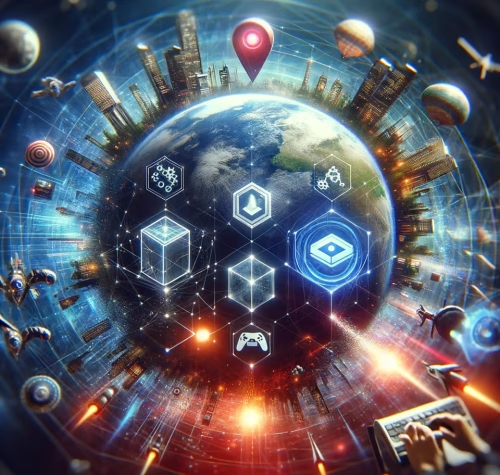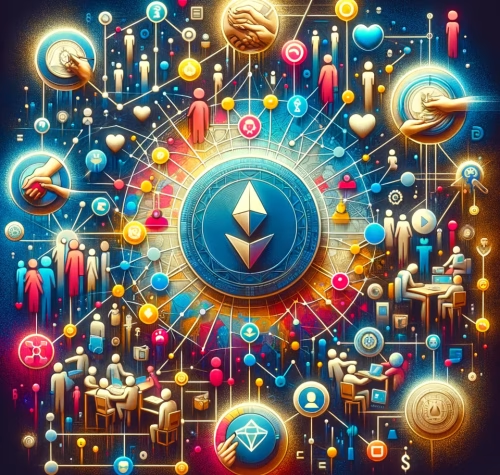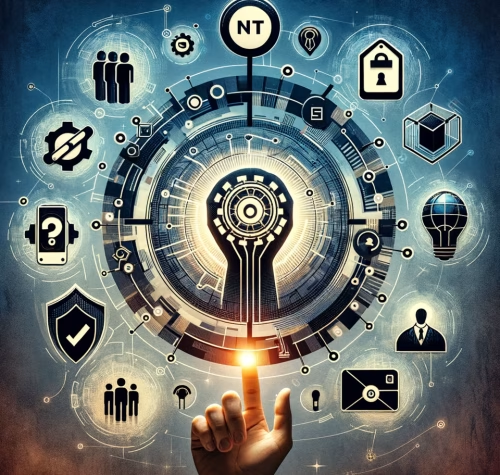
Welcome to our focused exploration of the emerging trends within the Non-Fungible Token (NFT) market as we head into 2024. This report is dedicated to uncovering the forefront of innovation and change in the NFT space, a rapidly evolving segment of the digital asset world.
The year 2024 stands as a pivotal moment for NFTs, as they continue to break new ground beyond the realms of digital art and collectibles. In this report, we delve into the key trends that are expected to shape the NFT market. From the integration of advanced technologies like AR and VR to the expansion of NFTs into new industries and applications, we explore the various dimensions that are set to redefine what NFTs represent and how they are used.
Our goal is to provide a comprehensive overview of the NFT landscape in 2024, offering valuable insights for creators, collectors, investors, and enthusiasts. Whether you’re deeply ingrained in the world of digital assets or just starting to navigate this exciting territory, this report aims to be a guide to the most significant trends and shifts that are expected to drive the future of NFTs.
As we venture into 2024, the Non-Fungible Token (NFT) market is poised to undergo a significant transformation, driven by groundbreaking technological advancements. This section delves into three pivotal trends reshaping the NFT landscape: the integration of AR and VR, the emergence of blockchain Layer 2 solutions, and the innovative use of AI in NFT creation.
The technological advancements in the NFT market for 2024 promise an exhilarating journey into the future of digital assets. From immersive AR/VR experiences to the efficiency of Layer 2 solutions and the creativity unleashed by AI, these trends are set to redefine the landscape of NFTs, offering new possibilities for creators, collectors, and enthusiasts alike.
Augmented Reality (AR) and Virtual Reality (VR) are set to significantly enhance the way we interact with NFTs in 2024. These technologies promise a more immersive and engaging experience, allowing collectors to interact with their digital assets in both real-world and virtual environments. In AR, digital objects can be overlaid in the user’s environment, while VR offers a fully immersive experience in digital worlds. This integration is expected to transform how we perceive and engage with NFTs, offering new ways to experience art and other digital assets (Source: NFTICALLY, Binance).
Layer 2 solutions like Arbitrum and Immutable X are enhancing the scalability and efficiency of NFT transactions. These solutions are designed to handle a higher volume of transactions at a lower cost, addressing some of the scalability issues faced by traditional blockchain networks. This trend is crucial for the growth and sustainability of the NFT market, making transactions faster and more cost-effective, thereby attracting a wider audience to the NFT space (Source: NFTICALLY).
Artificial Intelligence (AI) is increasingly being used to create unique NFT art and assets. In 2024, AI-generated art is expected to dominate the NFT art world, offering new forms of creativity and originality. AI tools allow artists to unlock unprecedented levels of creativity, producing innovative digital artwork for collectors. This trend is more than a mere technological advancement; it represents a paradigm shift in the NFT art world, heralding a new era of digital creativity (Source: NFT CULTURE).

The year 2024 marks a pivotal moment for the Non-Fungible Token (NFT) market, characterized by its significant expansion and diversification into various sectors. This section explores how NFTs are reshaping industries like gaming, real estate, and sports and entertainment, creating new opportunities and experiences.
In 2024, NFTs are expected to further integrate into the gaming sector and play a pivotal role in the development of the metaverse. Blockchain-based games are on the rise, with game developers increasingly incorporating Web3 elements to provide sophisticated in-game mechanics and gameplay. This integration is expected to enhance player engagement by allowing them to own and trade valuable in-game assets. Additionally, the metaverse is poised to become a game-changer for NFT gaming, offering new possibilities for building virtual worlds and experiences (Source: Cointelegraph, CoinDesk).
The real estate sector is witnessing a transformative shift with the tokenization of property assets via NFTs. Platforms like OpenSea, Decentraland, and others are enabling the purchase and trading of virtual real estate, paving the way for innovative investment opportunities. This trend allows for fractional ownership of properties and is expected to grow as the metaverse expands, providing new avenues for investment and development in virtual land and real estate (Source: NFT Droppers).
In the sports and entertainment industry, NFTs are revolutionizing the way fans interact with their favorite teams and celebrities. NFTs are being used to create exclusive collectibles, enhancing fan engagement and offering unique experiences. These tokenized assets serve as a bridge between fans and sports stars or entertainers, fostering a new dimension of fan loyalty and interaction. The trend points towards a more engaged and interactive relationship between fans and the sports and entertainment sectors (Source: NFTICALLY).

We are witnessing a transformative phase in the financial and economic aspects of Non-Fungible Tokens (NFTs). This section delves into two critical developments: the advent of fractional NFTs, making high-value assets more accessible, and the evolution of NFTs as robust financial instruments for investment and diversification.
Fractional NFTs are revolutionizing the concept of digital asset ownership by enabling the division of high-value NFTs into smaller, more affordable parts. This trend is democratizing access to what were once exclusive assets, allowing a broader audience to participate in the NFT market. Fractional ownership opens up new investment opportunities, making it possible for individuals to hold a stake in high-value digital artworks, collectibles, or other assets that would otherwise be out of reach. This approach not only diversifies investment portfolios but also enhances liquidity in the NFT market, as these fractionalized assets can be more readily bought and sold in the market.
NFTs are evolving beyond their traditional roles as digital art and collectibles to become significant financial instruments. They are increasingly being used for various financial purposes, including as collateral for loans, in yield farming, and as part of diverse investment strategies. This evolution reflects a growing recognition of the intrinsic value of NFTs, as well as their potential to serve as assets in diversified investment portfolios. The versatility of NFTs as financial instruments is poised to attract more investors to the space, who are looking to leverage the unique benefits of blockchain technology for financial gain.

The NFT space is increasingly becoming a hub for community empowerment and collaborative efforts. This section explores how NFTs are fostering the growth of decentralized autonomous organizations (DAOs) and the trend of social tokenization, reflecting the sector’s shift towards more community-centric and collaborative models.
NFTs are at the forefront of enabling community-driven projects and DAOs, where collective decision-making and decentralized governance are key. These organizations leverage the unique attributes of NFTs to foster collaboration, transparency, and shared ownership. In DAOs, NFTs can represent voting rights or membership, allowing community members to participate in governance and decision-making processes. This trend is not just about technology; it’s a cultural shift towards more democratic and decentralized models of organization and project management in the digital realm.
Social tokenization represents a significant trend where NFTs are used to signify membership, affiliation, and identity within communities. These tokens can grant access to exclusive content, events, or experiences, serving as a digital badge of membership. This trend is transforming how individuals interact with and contribute to online communities, turning passive participation into active engagement. Social tokenization via NFTs is creating new forms of digital identity and community belonging, redefining the very nature of social interaction in the digital age.

The realm of Non-Fungible Tokens is witnessing a significant shift, moving beyond digital collectibles to encompass more practical and impactful applications. This section delves into how NFTs are being innovatively used for identity verification and credentials, as well as offering practical utilities that extend their functionality in everyday life.
NFTs are increasingly being recognized for their potential in identity verification and credentialing. Leveraging the immutable and transparent nature of blockchain technology, NFTs can securely represent an individual’s identity, qualifications, and credentials. This application is particularly relevant in sectors where authenticity and verification are paramount, such as education, employment, and exclusive access to services or events. By tokenizing identity and credentials, NFTs offer a new layer of security and efficiency, streamlining processes that traditionally rely on paper-based or centralized digital systems.
Utility-driven NFTs are expanding the scope of what these digital assets can offer. Beyond being mere collectibles, they are now seen as tokens that provide practical value — such as access to exclusive events, memberships, services, or even physical products. This shift is transforming NFTs into a versatile tool for engagement and interaction, bridging the gap between the digital and physical worlds. Whether it’s gaining entry to a special event, accessing a subscription service, or claiming a physical item, utility-driven NFTs are redefining the user experience and engagement in various industries.
As we reflect on the diverse and innovative developments within the Non-Fungible Token (NFT) market, it’s clear that NFTs have transcended their initial role as digital collectibles to become multifaceted assets with far-reaching implications. The exploration of technological advancements, market expansion, financial evolution, social dynamics, and innovative use cases paints a picture of a domain that is not only vibrant and dynamic but also increasingly integral to various facets of our digital and physical lives.
The integration of cutting-edge technologies like AR, VR, and AI with NFTs, the expansion into sectors like gaming, real estate, and entertainment, and the evolution of NFTs as financial instruments and community drivers underscore the versatile nature of these digital assets. Moreover, the innovative applications of NFTs in identity verification and offering practical utilities signify a major shift in their function and relevance.
As we look to the future, it’s evident that the NFT market is poised for continued growth and innovation. The trends and developments discussed here are just the tip of the iceberg, indicating a future where NFTs could become ubiquitous in various aspects of our lives. From artists and creators to investors and everyday users, the expanding universe of NFTs offers a plethora of opportunities and challenges that will shape the digital asset landscape for years to come.
In conclusion, the journey through the evolving world of NFTs in this post highlights not just the technological and economic potential of these assets but also their capacity to foster community, creativity, and connectivity in an increasingly digital world. As the NFT market continues to evolve, it stands as a testament to the endless possibilities of innovation and collaboration in the digital age.
©2025 All Rights Reserved UNITE Web3 by UNITE Agency. Based in Switzerland, 1700 Fribourg.